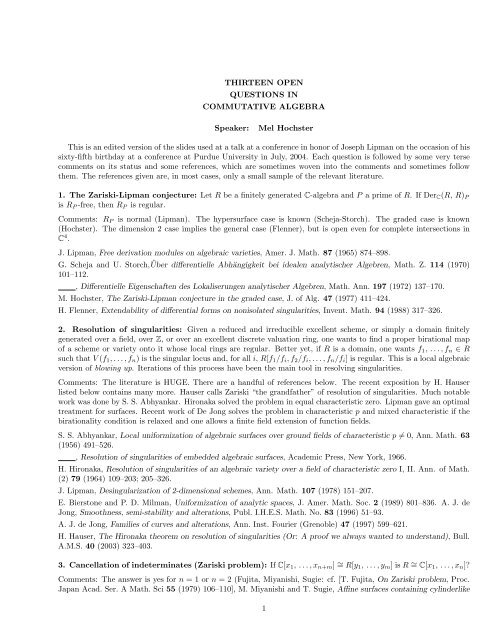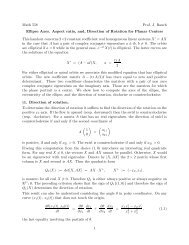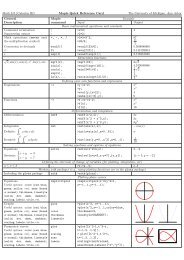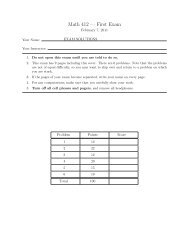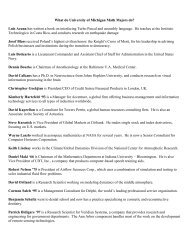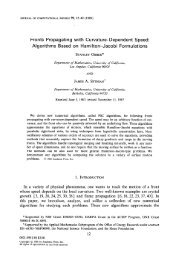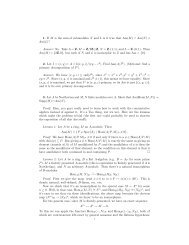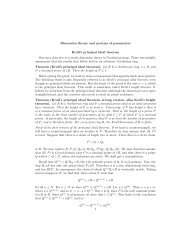Thirteen Open Questions in Commutative Algebra - University of ...
Thirteen Open Questions in Commutative Algebra - University of ...
Thirteen Open Questions in Commutative Algebra - University of ...
Create successful ePaper yourself
Turn your PDF publications into a flip-book with our unique Google optimized e-Paper software.
THIRTEEN OPEN<br />
QUESTIONS IN<br />
COMMUTATIVE ALGEBRA<br />
Speaker: Mel Hochster<br />
This is an edited version <strong>of</strong> the slides used at a talk at a conference <strong>in</strong> honor <strong>of</strong> Joseph Lipman on the occasion <strong>of</strong> his<br />
sixty-fifth birthday at a conference at Purdue <strong>University</strong> <strong>in</strong> July, 2004. Each question is followed by some very terse<br />
comments on its status and some references, which are sometimes woven <strong>in</strong>to the comments and sometimes follow<br />
them. The references given are, <strong>in</strong> most cases, only a small sample <strong>of</strong> the relevant literature.<br />
1. The Zariski-Lipman conjecture: Let R be a f<strong>in</strong>itely generated C-algebra and P a prime <strong>of</strong> R. If DerC(R, R)P<br />
is RP -free, then RP is regular.<br />
Comments: RP is normal (Lipman). The hypersurface case is known (Scheja-Storch). The graded case is known<br />
(Hochster). The dimension 2 case implies the general case (Flenner), but is open even for complete <strong>in</strong>tersections <strong>in</strong><br />
C 4 .<br />
J. Lipman, Free derivation modules on algebraic varieties, Amer. J. Math. 87 (1965) 874–898.<br />
G. Scheja and U. Storch, Über differentielle Abhängigkeit bei idealen analytischer Algebren, Math. Z. 114 (1970)<br />
101–112.<br />
, Differentielle Eigenschaften des Lokaliserungen analytischer Algebren, Math. Ann. 197 (1972) 137–170.<br />
M. Hochster, The Zariski-Lipman conjecture <strong>in</strong> the graded case, J. <strong>of</strong> Alg. 47 (1977) 411–424.<br />
H. Flenner, Extendability <strong>of</strong> differential forms on nonisolated s<strong>in</strong>gularities, Invent. Math. 94 (1988) 317–326.<br />
2. Resolution <strong>of</strong> s<strong>in</strong>gularities: Given a reduced and irreducible excellent scheme, or simply a doma<strong>in</strong> f<strong>in</strong>itely<br />
generated over a field, over Z, or over an excellent discrete valuation r<strong>in</strong>g, one wants to f<strong>in</strong>d a proper birational map<br />
<strong>of</strong> a scheme or variety onto it whose local r<strong>in</strong>gs are regular. Better yet, if R is a doma<strong>in</strong>, one wants f1, . . . , fn ∈ R<br />
such that V (f1, . . . , fn) is the s<strong>in</strong>gular locus and, for all i, R[f1/fi, f2/fi, . . . , fn/fi] is regular. This is a local algebraic<br />
version <strong>of</strong> blow<strong>in</strong>g up. Iterations <strong>of</strong> this process have been the ma<strong>in</strong> tool <strong>in</strong> resolv<strong>in</strong>g s<strong>in</strong>gularities.<br />
Comments: The literature is HUGE. There are a handful <strong>of</strong> references below. The recent exposition by H. Hauser<br />
listed below conta<strong>in</strong>s many more. Hauser calls Zariski “the grandfather” <strong>of</strong> resolution <strong>of</strong> s<strong>in</strong>gularities. Much notable<br />
work was done by S. S. Abhyankar. Hironaka solved the problem <strong>in</strong> equal characteristic zero. Lipman gave an optimal<br />
treatment for surfaces. Recent work <strong>of</strong> De Jong solves the problem <strong>in</strong> characteristic p and mixed characteristic if the<br />
birationality condition is relaxed and one allows a f<strong>in</strong>ite field extension <strong>of</strong> function fields.<br />
S. S. Abhyankar, Local uniformization <strong>of</strong> algebraic surfaces over ground fields <strong>of</strong> characteristic p = 0, Ann. Math. 63<br />
(1956) 491–526.<br />
, Resolution <strong>of</strong> s<strong>in</strong>gularities <strong>of</strong> embedded algebraic surfaces, Academic Press, New York, 1966.<br />
H. Hironaka, Resolution <strong>of</strong> s<strong>in</strong>gularities <strong>of</strong> an algebraic variety over a field <strong>of</strong> characteristic zero I, II. Ann. <strong>of</strong> Math.<br />
(2) 79 (1964) 109–203; 205–326.<br />
J. Lipman, Des<strong>in</strong>gularization <strong>of</strong> 2-dimensional schemes, Ann. Math. 107 (1978) 151–207.<br />
E. Bierstone and P. D. Milman, Uniformization <strong>of</strong> analytic spaces, J. Amer. Math. Soc. 2 (1989) 801–836. A. J. de<br />
Jong, Smoothness, semi-stability and alterations, Publ. I.H.E.S. Math. No. 83 (1996) 51–93.<br />
A. J. de Jong, Families <strong>of</strong> curves and alterations, Ann. Inst. Fourier (Grenoble) 47 (1997) 599–621.<br />
H. Hauser, The Hironaka theorem on resolution <strong>of</strong> s<strong>in</strong>gularities (Or: A pro<strong>of</strong> we always wanted to understand), Bull.<br />
A.M.S. 40 (2003) 323–403.<br />
3. Cancellation <strong>of</strong> <strong>in</strong>determ<strong>in</strong>ates (Zariski problem): If C[x1, . . . , xn+m] ∼ = R[y1, . . . , ym] is R ∼ = C[x1, . . . , xn]?<br />
Comments: The answer is yes for n = 1 or n = 2 (Fujita, Miyanishi, Sugie: cf. [T. Fujita, On Zariski problem, Proc.<br />
Japan Acad. Ser. A Math. Sci 55 (1979) 106–110], M. Miyanishi and T. Sugie, Aff<strong>in</strong>e surfaces conta<strong>in</strong><strong>in</strong>g cyl<strong>in</strong>derlike<br />
1
open sets, J. Math. Kyoto Univ. 20 (1980) 11–42], and [T. Sugie, Characterization <strong>of</strong> the aff<strong>in</strong>e plane and the<br />
aff<strong>in</strong>e threespace, <strong>in</strong> Topological Methods <strong>in</strong> <strong>Algebra</strong>ic Transformation Groups (editors H. Kraft, T. Petrie, and G. W.<br />
Schwarz), Progress <strong>in</strong> Math. 80, Birkhäuser, Boston-Basel-Berl<strong>in</strong>, 1989, 177–190].)<br />
Be wary about cancellation!<br />
Let R, S be C[x, y, z]/ xy − (1 − z 2 ) , C[x, y, z]/ x 2 y − (1 − z 2 ) . R ∼ = S but R[t] ∼ = S[t] ! (Danielewski surfaces.)<br />
Cf. [W. Danielewski, On the cancellation problem and automorphism groups <strong>of</strong> aff<strong>in</strong>e algebraic varieties, prepr<strong>in</strong>t,<br />
Warsaw, 1989], [K.-H. Fieseler, On complex aff<strong>in</strong>e surfaces with C + -action, Comment. Math. Helv. 69 (1994) 5–27].<br />
4. The Jacobian conjecture: If R = C[x1, . . . , xn], and f : R → R with f(xi) = fi for 1 ≤ i ≤ n is such that<br />
det(∂fi/∂xj) ∈ C − {0}, then f is an automorphism.<br />
Comments: There have been many <strong>in</strong>correct pro<strong>of</strong>s: several have been published. Cf. [H. Bass, E. Connell, and<br />
D. Wright, The Jacobian Conjecture: reduction <strong>of</strong> degree and formal expansion <strong>of</strong> the <strong>in</strong>verse, Bull. A.M.S. 7 (1982)<br />
287–330]. The question rema<strong>in</strong>s open even if n = 2. A survey is given <strong>in</strong> [A. van den Essen, Polynomial automorphisms<br />
and the Jacobian conjecture, Algèbre non commutative, groupes quantiques et <strong>in</strong>variants (Reims, 1995), 55–81, Sém<strong>in</strong>.<br />
Congr., 2, Soc. Math. France, Paris, 1997.]<br />
5. Set-theoretic def<strong>in</strong>ition: Is there a method for determ<strong>in</strong><strong>in</strong>g the least number <strong>of</strong> generators <strong>of</strong> an ideal up to<br />
radicals (how many equations are needed to def<strong>in</strong>e an algebraic set)?<br />
This seems <strong>in</strong>credibly difficult. It is not known whether every irreducible curve <strong>in</strong> A3 C is even locally a set-theoretic<br />
complete <strong>in</strong>tersection! It is not known whether, for example, the parametric Moh curve<br />
x = t 6 + t 31 , y = t 8 , z = t 10<br />
is a set-theoretic complete <strong>in</strong>tersection at the orig<strong>in</strong>! Cf. [G. Lyubeznik, A survey <strong>of</strong> problems and results on the<br />
number <strong>of</strong> def<strong>in</strong><strong>in</strong>g equations, <strong>in</strong> <strong>Commutative</strong> <strong>Algebra</strong> M.S.R.I. Publ. 15 Spr<strong>in</strong>ger-Verlag, New York, 1989, 375–390].<br />
6. The strong <strong>in</strong>tersection conjecture: Let (R, m) be a local (Noetherian) r<strong>in</strong>g and let M, N = 0 be f<strong>in</strong>itely<br />
generated R-modules such that pd RM < ∞ and M ⊗R N has f<strong>in</strong>ite length. Let I = AnnRM. Then dim (N) ≤<br />
depth IR.<br />
Comments: Cf. [C. Pesk<strong>in</strong>e and L. Szpiro, Dimension projective f<strong>in</strong>ie et cohomologie locale, Publ. I.H.E.S. 42,<br />
1973].Many other questions considered there have been settled, <strong>in</strong>clud<strong>in</strong>g conjectures <strong>of</strong> H. Bass and M. Auslander.<br />
In equal characteristic several follow from the existence <strong>of</strong> big Cohen-Macaulay modules. In mixed characteristic,<br />
others were settled by P. Roberts us<strong>in</strong>g <strong>in</strong>tersection theory. M. Auslander’s rigidity conjecture was settled negatively<br />
by R. Heitmann. See also:<br />
M. Hochster, Topics <strong>in</strong> the homological theory <strong>of</strong> modules over commutative r<strong>in</strong>gs, C.B.M.S. Regional Conf. Ser. <strong>in</strong><br />
Math. No. 24, Amer. Math. Soc., Providence, R.I., 1975.<br />
P. Roberts, Le théorème d’<strong>in</strong>tersection, C.R. Acad. Sc. Paris Sér. I 304 (1987) 177–180.<br />
P. Roberts, Multiplicities and Chern classes <strong>in</strong> local algebra, Cambridge Tracts <strong>in</strong> Mathematics 133, Cambridge Univ.<br />
Press, Cambridge, England, 1998.<br />
R. Heitmann, A counterexample to the rigidity conjecture for r<strong>in</strong>gs, Bull. A.M.S. New Series 29 (1993) 94–97.<br />
7. The Buchsbaum-Eisenbud-Horrocks problem: If R is regular local, dim (R) = n, and ℓ(M) < ∞, then the<br />
j th Betti number <strong>of</strong> M is ≥ n<br />
j .<br />
Comments: See D. Buchsbaum and D. Eisenbud, <strong>Algebra</strong> structures for f<strong>in</strong>ite free resolutions and some structure<br />
theorems for ideals <strong>of</strong> codimension 3, Amer. J. Math. 99 (1977) 447–485 and R. Hartshorne, <strong>Algebra</strong>ic vector bundles<br />
on projective spaces: a problem list, Topology 18 (1979) 117–128. This is known if dim (R) ≤ 4. Weaker form: the<br />
sum <strong>of</strong> the Betti numbers is at least 2n . Stronger form: the torsion-free rank <strong>of</strong> a m<strong>in</strong>imal j th module <strong>of</strong> syzygies<br />
is ≥ n−1<br />
j−1 , 1 ≤ j ≤ n. Closely related: if ℓ(M) < ∞ over (R, m), a local r<strong>in</strong>g, and x = x1, . . . , xn ∈ m, then<br />
ℓ Hj(x; M) ≥ n<br />
j .<br />
Another somewhat related question: if I, J ⊆ R with (R, m) regular local, dim (R) = n, and I + J m-primary<br />
then Tor R 1 (R/I, R/J) needs ≥ n − dim (R/I) − dim (R/J) generators. (This is open for K[[x, y, z]] even if I, J are<br />
m-primary: one expects (I ∩ J)/IJ to need at least three generators.)<br />
2
The orig<strong>in</strong>al problem asks for a lower bound for the dimension <strong>of</strong> Tor R j (M, K). The second asks for a lower bound for<br />
the dimension <strong>of</strong> Tor R 0 (Tor R 1 (R/I, R/J), K). One may ask, more generally, for lower bounds for the dimensions <strong>of</strong> more<br />
complicated iterated Tor modules under various conditions on the <strong>in</strong>put modules. Why make it harder? Sometimes,<br />
the “harder” question is easier.<br />
Another closely related question: Let (A, m) be an Art<strong>in</strong> local r<strong>in</strong>g and let x1, . . . , xn ∈ m. Is the number <strong>of</strong> generators<br />
<strong>of</strong> H1(x1, . . . , xn; A) at least n? This is true if n = 1 and n = 2 (S. Dutta).<br />
8. Positivity <strong>of</strong> Serre multiplicities: Let (R, m) be regular local, dim (R) = n. Let M, N be Noetherian Rmodules<br />
with ℓ(M ⊗R N) < ∞. If χ(M, N)= n j=1ℓTor R j (M, N) then:<br />
(1) dim M + dim N ≤ dim R, (2) χ(M, N) ≥ 0, and (3) χ(M, N) > 0 iff equality holds <strong>in</strong> (1).<br />
Comments: This was proved by Serre if R conta<strong>in</strong>s a field or if R is formal power series over a DVR. Serre proved (1)<br />
<strong>in</strong> general. Cf. [J.-P. Serre, Algèbre local · Multiplicités, Spr<strong>in</strong>ger-Verlag Lecture Notes <strong>in</strong> Math. 11, Spr<strong>in</strong>ger-Verlag,<br />
New York, 1961. That χ vanishes when it should was proved <strong>in</strong> [P. Roberts, The vanish<strong>in</strong>g <strong>of</strong> <strong>in</strong>tersection multiplicities<br />
<strong>of</strong> perfect complexes, Bull. A.M.S. 13 (1985) 127–130] and [H. Gillet and C. Soulé, K-théorie et nullité des multiplicités<br />
d’<strong>in</strong>tersection, C. R. Acad. Sci. Paris Série I no. 3 t. 300 (1985) 71–74 ]. (2) was proved by O. Gabber: an exposition<br />
is given <strong>in</strong> [P. Berthelot, Altérations de variétes algébriques [d’après A. J. de Jong], Sém<strong>in</strong>aire BOURBAKI, 48ème<br />
année, n o 815, 815-01 – 815-39] us<strong>in</strong>g De Jong’s alterations. Positivity <strong>of</strong> multiplicities rema<strong>in</strong>s a frustrat<strong>in</strong>g open<br />
question. It is implied by the existence <strong>of</strong> small Cohen-Macaulay modules, considered <strong>in</strong> 12. below.<br />
9. Direct summands <strong>of</strong> regular r<strong>in</strong>gs are Cohen-Macaulay: If R is a direct summand as an R-module <strong>of</strong> a<br />
regular r<strong>in</strong>g S, then must R be Cohen-Macaulay?<br />
This is easy if S is module-f<strong>in</strong>ite over R. It is known <strong>in</strong> equal char.: cf. [M. Hochster and J. L. Roberts, R<strong>in</strong>gs<br />
<strong>of</strong> <strong>in</strong>variants <strong>of</strong> reductive groups act<strong>in</strong>g on regular r<strong>in</strong>gs are Cohen-Macaulay, Advances <strong>in</strong> Math. 13 (1974) 115–<br />
175], [M. Hochster and C. Huneke, Applications <strong>of</strong> the existence <strong>of</strong> big Cohen-Macaulay algebras, Advances <strong>in</strong> Math.<br />
113 (1995), 45–117], and [ , Tight closure <strong>in</strong> equal characteristic zero, Spr<strong>in</strong>ger-Verlag, to appear]. The result<br />
for f<strong>in</strong>itely generated C-algebras is sharpened <strong>in</strong> [J.-F. Boutot, S<strong>in</strong>gularités rationelles et quotients par les groupes<br />
réductifs, Invent. Math. 88 (1987) 65–68]: if S has rational s<strong>in</strong>gularities and R is a direct summand, then R has<br />
rational s<strong>in</strong>gularities. The question is open <strong>in</strong> mixed characteristic. It would follow from a solution <strong>of</strong> the fourth form<br />
<strong>of</strong> the problem considered <strong>in</strong> 12. or from a solution <strong>of</strong> 13.<br />
10. The direct summand and canonical element conjectures; understand<strong>in</strong>g superheight: Let R be<br />
regular and R ⊆ S module-f<strong>in</strong>ite. Is R a direct summand <strong>of</strong> S?<br />
This is trivial if R ⊇ Q (and then R need only be normal), and was proved <strong>in</strong> char. p > 0 <strong>in</strong> [M. Hochster, Contracted<br />
ideals from <strong>in</strong>tegral extensions <strong>of</strong> regular r<strong>in</strong>gs, Nagoya Math. J. 51 (1973) 25–43]. It is easy <strong>in</strong> dimension ≤ 2. It<br />
reduces to the case <strong>of</strong> formal power series over a DVR <strong>in</strong> which p generates the maximal ideal. In [R. C. Heitmann, The<br />
direct summand conjecture <strong>in</strong> dimension three, Annals <strong>of</strong> Math. (2) 156 (2002) 695–712] the result was f<strong>in</strong>ally proved<br />
<strong>in</strong> mixed characteristic <strong>in</strong> dimension 3. The direct summand conjecture rema<strong>in</strong>s open if dim (R) ≥ 4. An equivalent<br />
conjecture (although it “appears” stronger) is that: if (R, m, K) is local and x = x1, . . . , xn is a system <strong>of</strong> parameters,<br />
if one maps the Koszul complex K• = K•(x; R) to a free m<strong>in</strong>imal resolution G• <strong>of</strong> K beg<strong>in</strong>n<strong>in</strong>g with 1R, then the<br />
<strong>in</strong>duced map Kn = R → syz nK is such that the image <strong>of</strong> 1 is not <strong>in</strong> (x)syz nK. Lett<strong>in</strong>g the system <strong>of</strong> parameters<br />
vary, one sees that one has a (conjecturally nonzero) canonical element <strong>in</strong> Hn m(syz nK), or, as po<strong>in</strong>ted out to me<br />
by Joe Lipman, a (conjecturally, nonzero) canonical element <strong>in</strong> Tor R n<br />
K, H n m(R) . Us<strong>in</strong>g that the direct summand<br />
conjecture implies the canonical element conjecture, one sees that it implies many <strong>of</strong> the early local homological<br />
conjectures (known from Roberts’ work). Cf. [M. Hochster, Canonical elements <strong>in</strong> local cohomology modules and the<br />
direct summand conjecture, J. <strong>of</strong> <strong>Algebra</strong> 84 (1983) 503–553].<br />
The direct summand conjecture is also equivalent to the statement that if x1, . . . , xn is a system <strong>of</strong> parameters <strong>of</strong><br />
a local r<strong>in</strong>g (R, m), then (x1 · · · xn) t /∈ (x t+1<br />
1 , . . . , xt+1 n )R (the monomial conjecture). Another equivalent statement<br />
is this: if (V, x1V ) is a complete DVR and T = V [[x2, ..., xn, y1, . . . , yn]], and f = (x1 · · · xn) t − n j=1 yjxt j , then, if<br />
R = T/fT , for any map R → S, ht (x1, . . . , xn)S, if f<strong>in</strong>ite, is ≤ n − 1. More generally, one may ask: can one tell what<br />
the largest height a proper expansion <strong>of</strong> an ideal I <strong>of</strong> a Noetherian r<strong>in</strong>g R to a Noetherian R-algebra S can achieve?<br />
I.e., what is the superheight <strong>of</strong> I? The problem rema<strong>in</strong>s unsolved even <strong>in</strong> simple special cases <strong>in</strong> low dimension.<br />
3
11. Localization <strong>of</strong> tight closure; tight closure vs. plus closure: If R is an excellent Noetherian doma<strong>in</strong>, char.<br />
p > 0, does the tight closure I ∗ <strong>of</strong> I commute with localization? Is it the same as the elements <strong>in</strong> IR + ∩ I, where R +<br />
is the <strong>in</strong>tegral closure <strong>of</strong> R <strong>in</strong> an algebraic closure <strong>of</strong> its fraction field?<br />
Comments. Recall that u ∈ I ∗ if for some c = 0, cu pe<br />
∈ I [pe ] ∀e ≫ 0, where I [p e ] = (i p e<br />
: i ∈ I)R.<br />
IR + ∩ R ⊆ I ∗ . By [K. E. Smith,Tight closure <strong>of</strong> parameter ideals, Invent. Math. 115 (1994) 41–60] they are equal if<br />
IRP is generated by part <strong>of</strong> a system <strong>of</strong> parameters <strong>in</strong> RP for all P ⊇ I. Brenner [H. Brenner, Tight closure and plus<br />
closure for cones over elliptic curves, prepr<strong>in</strong>t], [ , Tight closure and plus closure <strong>in</strong> dimension two, prepr<strong>in</strong>t] has<br />
done the case <strong>of</strong> homogeneous ideals <strong>in</strong> the homogeneous coord<strong>in</strong>ate r<strong>in</strong>gs <strong>of</strong> elliptic curves and <strong>of</strong> other nons<strong>in</strong>gular<br />
curves if the base field is the algebraic closure <strong>of</strong> Z/pZ.<br />
Plus closure commutes with localization, and so the second question would solve the localization problem for tight<br />
closure.<br />
12. Existence <strong>of</strong> (big) Cohen-Macaulay (C-M) modules and algebras. Let (R, m, K) be local. We shall say<br />
here that M is a big C-M module or algebra if mM = M and every system <strong>of</strong> parameters R is a regular sequence on<br />
M. We say that M is a (small) C-M module if it is f<strong>in</strong>itely generated.<br />
(1) Does every complete local doma<strong>in</strong> have a small C-M module?<br />
(2) Do there exist big C-M modules?<br />
(3) Do there exist big C-M algebras?<br />
(4) Given a local map <strong>of</strong> complete local doma<strong>in</strong>s R → S do there exist big C-M algebras BR, BS and an R-algebra<br />
map BR → BS (weakly functorial big C-M algebras).<br />
(5) Does a version <strong>of</strong> tight closure theory exist <strong>in</strong> mixed characteristic?<br />
Comments: both (2), and (3) reduce to the case <strong>of</strong> complete (even normal) local doma<strong>in</strong>s. Small C-M modules are<br />
known to exist <strong>in</strong> dimension 2 and for f<strong>in</strong>itely generated N-graded doma<strong>in</strong>s R <strong>of</strong> char. p > 0 with R0 a perfect field if<br />
the r<strong>in</strong>g has an isolated non-C-M po<strong>in</strong>t at the orig<strong>in</strong>: this was first observed by R. Hartshorne. The argument is given<br />
<strong>in</strong> [M. Hochster, Big Cohen-Macaulay modulesand algebras and embeddability <strong>in</strong> r<strong>in</strong>gs <strong>of</strong> Witt vectors, <strong>in</strong> Proceed<strong>in</strong>gs<br />
<strong>of</strong> the Queen’s <strong>University</strong> <strong>Commutative</strong> <strong>Algebra</strong> Conference, Queen’s Papers <strong>in</strong> Pure and Applied Math., No. 42,<br />
1975, 106–195].<br />
Big C-M modules were shown to exist <strong>in</strong> equal char. (us<strong>in</strong>g reduction to char. p) <strong>in</strong> [ , Topics <strong>in</strong> the Homological<br />
Theory <strong>of</strong> Modules over <strong>Commutative</strong> R<strong>in</strong>gs, Proceed<strong>in</strong>gs <strong>of</strong> the Nebraska Regional C.B.M.S. Conference, (L<strong>in</strong>coln,<br />
Nebraska, 1974), A.M.S., Providence, 1975]. (4) was proved <strong>in</strong> char. p¿0 <strong>in</strong> [ and C. Huneke, Inf<strong>in</strong>ite <strong>in</strong>tegral<br />
extensions and big Cohen-Macaulay algebras, Annals <strong>of</strong> Math. 135 (1992) 53–89]: R + works, and <strong>in</strong> char. 0 <strong>in</strong> the<br />
sequel [ , Applications <strong>of</strong> the existence <strong>of</strong> big Cohen-Macaulay algebras, Advances <strong>in</strong> Math. 113 (1995) 45–117].<br />
But (4) is also true for two r<strong>in</strong>gs <strong>of</strong> mixed char. <strong>in</strong> dimension ≤ 3. This is shown, mak<strong>in</strong>g use <strong>of</strong> Heitmann’s results,<br />
<strong>in</strong> [M. Hochster, Big Cohen-Macaulay algebras <strong>in</strong> dimension three via Heitmann’s theorem, J. <strong>of</strong> Alg. 254 (2002)<br />
395–408]. I have heuristic reasons for believ<strong>in</strong>g that the problem <strong>of</strong> prov<strong>in</strong>g (4) <strong>in</strong> mixed characteristic <strong>in</strong> general and<br />
the problem <strong>of</strong> develop<strong>in</strong>g an analogue <strong>of</strong> tight closure <strong>in</strong> mixed characteristic should be nearly equivalent.<br />
13. The vanish<strong>in</strong>g conjecture for maps <strong>of</strong> Tor and the strong direct summand conjecture: If A ⊆ R → S<br />
are Noetherian r<strong>in</strong>gs with A, S regular and R is module-f<strong>in</strong>ite and torsion-free over A, the Tor A i (M, R) → Tor R i (M, S)<br />
is 0 for all A-modules M and all i ≥ 1.<br />
Comments: This can be proved <strong>in</strong> equal characteristic us<strong>in</strong>g either tight closure theory or the weakly functorial<br />
existence <strong>of</strong> big C-M algebras. This powerful result implies both the direct summand conjecture (when S is a field)<br />
and the conjecture that direct summands <strong>of</strong> regular r<strong>in</strong>gs are Cohen-Macaulay (when (A, M, K) is regular local M = K,<br />
and i = 1). Cf. [M. Hochster and C. Huneke, Applications <strong>of</strong> the existence <strong>of</strong> big Cohen-Macaulay algebras, Advances<br />
<strong>in</strong> Math. 113 (1995) 45–117]. f In mixed characteristic, it is a conjecture.<br />
In [N. Ranganathan, Splitt<strong>in</strong>g <strong>in</strong> module-f<strong>in</strong>ite extension r<strong>in</strong>gs and the vanish<strong>in</strong>g conjecture for maps <strong>of</strong> Tor, Thesis,<br />
<strong>University</strong> <strong>of</strong> Michigan, 2000] the surpris<strong>in</strong>g result is obta<strong>in</strong>ed that 13. is equivalent to the follow<strong>in</strong>g strong direct<br />
summand conjecture: let (R, m, K) be a regular local r<strong>in</strong>g <strong>in</strong> which x ∈ m − m 2 , let S be a module f<strong>in</strong>ite extension<br />
doma<strong>in</strong>, and let Q be a height one prime <strong>of</strong> S ly<strong>in</strong>g over xR. Then xR ⊆ Q splits as a map <strong>of</strong> R-modules (which implies<br />
that R splits from S). There is no easy pro<strong>of</strong> known <strong>in</strong> equal char. 0, and the result is open <strong>in</strong> mixed characteristic.<br />
4
Here is one not-so-open question: In [Y. Kamoi, K. Kurano, On maps <strong>of</strong> Grothendieck groups <strong>in</strong>duced by completion,<br />
J. Alg. 254 (2002) 21–43] it’s shown that for a local r<strong>in</strong>g R, G0(R) → G0( R) is <strong>in</strong>jective if R is excellent and<br />
either Henselian, or has an isolated s<strong>in</strong>gularity, or is the local r<strong>in</strong>g <strong>of</strong> an N-graded algebra <strong>of</strong> f<strong>in</strong>ite type over a field.<br />
The authors didn’t know an example <strong>of</strong> non-<strong>in</strong>jectivity.<br />
Here’s an example: let T = K[x, y, u, v]m and R = T/fT where f = xy − ux 2 − yv 2 . f factors <strong>in</strong> T and P = (x, y)R<br />
becomes pr<strong>in</strong>cipal mod either <strong>of</strong> the the two m<strong>in</strong>imal primes <strong>of</strong> R. But [R/(x, y)] = 0 (it is 2-torsion) <strong>in</strong> G0(R), even if<br />
one maps to RP . If you are sad that this is not open here’s someth<strong>in</strong>g to th<strong>in</strong>k about: I don’t know a counter-example<br />
if R is normal (conjecture: there is one).<br />
Homework: settle one.<br />
Due: May 18, 2009<br />
•Zariski-Lipman conjecture<br />
•Resolution <strong>of</strong> s<strong>in</strong>gularities<br />
•Cancellation <strong>of</strong> <strong>in</strong>determ<strong>in</strong>ates<br />
•Jacobian conjecture<br />
•Set-theoretic def<strong>in</strong>ition<br />
•Strong <strong>in</strong>tersection<br />
•Buchsbaum-Eisenbud-Horrocks problem<br />
•Serreconjecture on positivity <strong>of</strong> multiplicities<br />
•Direct summand <strong>of</strong> regular is Cohen-Macaulay<br />
•Direct summand conjecture<br />
•Tight closure commutes with localization<br />
•Existence <strong>of</strong> big and/or small Cohen-Macaulay algebras or modules<br />
•Vanish<strong>in</strong>g <strong>of</strong> maps <strong>of</strong> Tor<br />
5


